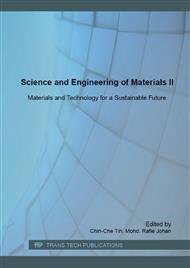[1]
P. Kaur, J. T. Hupp, and S. T. Nguyen, Porous Organic Polymers in Catalysis: Opportunities and Challenges, ACS Catal., vol. 1, pp.819-835, (2011).
DOI: 10.1021/cs200131g
Google Scholar
[2]
D. Yuan, W. Lu, D. Zhao, and H. -C. Zhou, Highly Stable Porous Polymer Networks with Exceptionally High Gas-Uptake Capacities, Adv. Mater., vol. 23, pp.3723-3725, (2011).
DOI: 10.1002/adma.201101759
Google Scholar
[3]
S. -i. Noro, J. Mizutani, Y. Hijikata, R. Matsuda, H. Sato, S. Kitagawa, K. Sugimoto, Y. Inubushi, K. Kubo, and T. Nakamura, Porous coordination polymers with ubiquitous and biocompatible metals and a neutral bridging ligand, Nat Commun, vol. 6, (2015).
DOI: 10.1038/ncomms6851
Google Scholar
[4]
Z. Xiang and D. Cao, Porous covalent-organic materials: synthesis, clean energy application and design, J. Mater. Chem. A, vol. 1, pp.2691-2718, (2013).
DOI: 10.1039/c2ta00063f
Google Scholar
[5]
T. Ben, H. Ren, S. Ma, D. Cao, J. Lan, X. Jing, W. Wang, J. Xu, F. Deng, J. M. Simmons, S. Qiu, and G. Zhu, Targeted Synthesis of a Porous Aromatic Framework with High Stability and Exceptionally High Surface Area, Angew Chem-Ger Edit, vol. 121, pp.9621-9624, (2009).
DOI: 10.1002/ange.200904637
Google Scholar
[6]
H. Furukawa, N. Ko, Y. B. Go, N. Aratani, S. B. Choi, E. Choi, A. Ö. Yazaydin, R. Q. Snurr, M. O'Keeffe, J. Kim, and O. M. Yaghi, Ultrahigh Porosity in Metal-Organic Frameworks, Sci., vol. 329, pp.424-428, (2010).
DOI: 10.1126/science.1192160
Google Scholar
[7]
Z. Xiang, X. Zhou, C. Zhou, S. Zhong, X. He, C. Qin, and D. Cao, Covalent-organic polymers for carbon dioxide capture, J. Mater. Chem., vol. 22, pp.22663-22669, (2012).
DOI: 10.1039/c2jm35446b
Google Scholar
[8]
H. A. Patel, F. Karadas, A. Canlier, J. Park, E. Deniz, Y. Jung, M. Atilhan, and C. T. Yavuz, High capacity carbon dioxide adsorption by inexpensive covalent organic polymers, J. Mater. Chem., vol. 22, pp.8431-8437, (2012).
DOI: 10.1039/c2jm30761h
Google Scholar
[9]
H. A. Patel, F. Karadas, J. Byun, J. Park, E. Deniz, A. Canlier, Y. Jung, M. Atilhan, and C. T. Yavuz, Highly Stable Nanoporous Sulfur-Bridged Covalent Organic Polymers for Carbon Dioxide Removal, Adv. Funct. Mater., vol. 23, pp.2270-2276, (2013).
DOI: 10.1002/adfm.201202442
Google Scholar
[10]
H. A. Patel, S. Hyun Je, J. Park, D. P. Chen, Y. Jung, C. T. Yavuz, and A. Coskun, Unprecedented high-temperature CO2 selectivity in N2-phobic nanoporous covalent organic polymers, Nat Commun, vol. 4, p.1357, (2013).
DOI: 10.1038/ncomms2359
Google Scholar
[11]
Y. Zhou, Z. Xiang, D. Cao, and C. -J. Liu, Covalent organic polymer supported palladium catalysts for CO oxidation, Chem. Commun., vol. 49, pp.5633-5635, (2013).
DOI: 10.1039/c3cc00287j
Google Scholar
[12]
Z. Xiang and D. Cao, Synthesis of Luminescent Covalent–Organic Polymers for Detecting Nitroaromatic Explosives and Small Organic Molecules, Macromol. Rapid Commun., vol. 33, pp.1184-1190, (2012).
DOI: 10.1002/marc.201100865
Google Scholar
[13]
C. Kotoulas and C. Kiparissides, A generalized population balance model for the prediction of particle size distribution in suspension polymerization reactors, Chem. Eng. Sci., vol. 61, pp.332-346, (2006).
DOI: 10.1016/j.ces.2005.07.013
Google Scholar
[14]
F. Rouquerol, J. Rouquerol, and K. Sing, Chapter 13 - General Conclusions and Recommendations, in Adsorption by Powders and Porous Solids, F. Rouquerol, et al., Eds., ed London: Academic Press, pp.439-447, (1999).
DOI: 10.1016/b978-012598920-6/50014-2
Google Scholar


